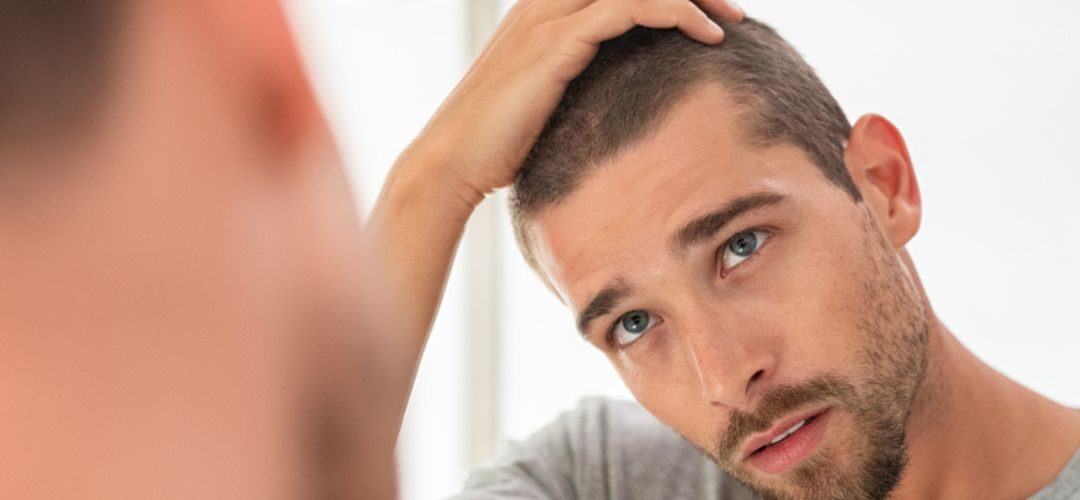Have you looked into the mirror each morning, noticing thinning hair? Or maybe even the beginnings of a bald spot on the crown of your head?
You’re only in your mid 20s, so how could you be losing your hair already? You’re much too young for this to be happening.
Does this sound like a familiar scenario?
Well, you’re not alone, with one study showing approximately 16% of men between the ages of 18 and 29 years reporting early hair loss.
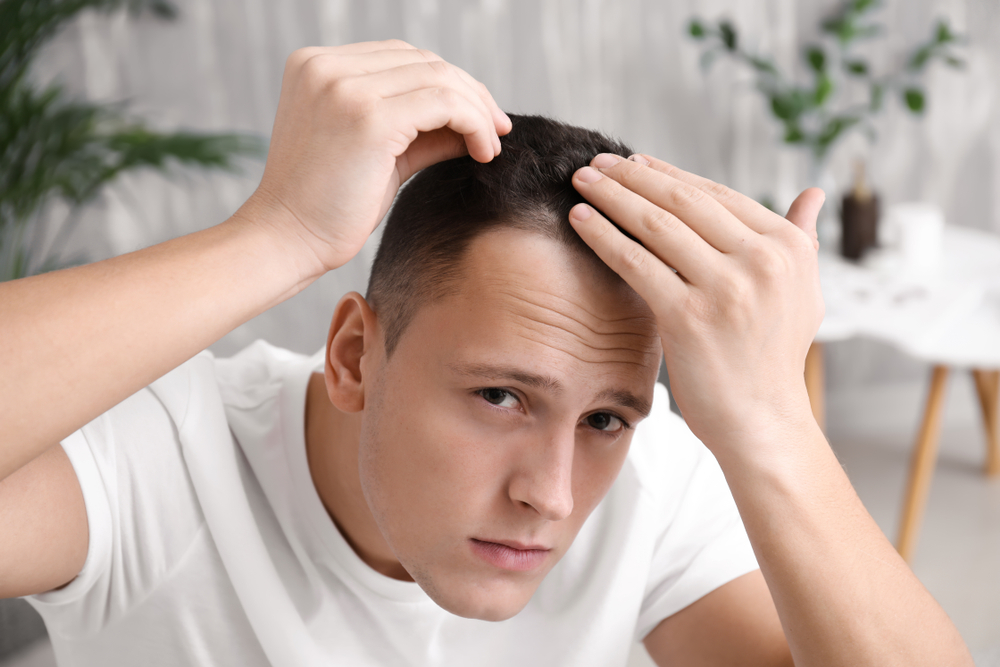
While this can be a disheartening realisation, we’re here to put your mind at ease, as we explain all you need to know about hair loss in your 20s – and how you can treat this condition to keep your hair well into your 30s, 40s and beyond.
Everything you need to know about fast hair loss – mid 20s
Although hair loss was once more commonly associated with older generations, it is now not unusual for men in their mid 20s to notice the early stages of balding or hair thinning. While it may be a confronting realisation to notice the initial signs of hair loss, new data has revealed that young men are increasingly likely to lose hair at a younger stage in life, due to busy and stressful lifestyles.
Male pattern baldness is the most common form of hair loss amongst men and was only associated with older gentlemen, once upon a time. Now, the affects of the male pattern baldness type of hair loss in men are advancing at a younger age, often triggered by everyday stressors.
In addition to the early onset of male pattern baldness, as the body ages, both men and women experience thinning hair and balding, directly related to hormonal factors. As men age, testosterone levels naturally decreases, commonly causing more noticeable hair loss.
The question of when you will start losing hair relies upon a variety of outside influences. Genetics, family history, general health and your everyday lifestyle choices all factor into the equation.
Is thinning hair normal in your 20s?
Studies have shown that more than 42% of men will experience moderate to extensive hair loss throughout some stage of life, while more than 70% of all men will suffer from some degree of hair loss.
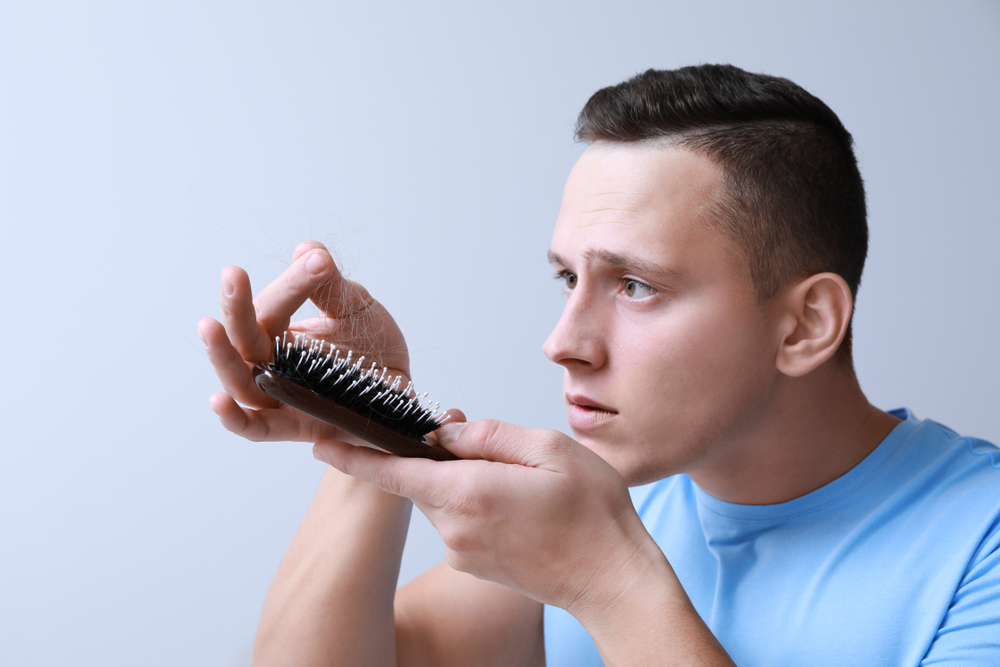
Andrea Hui, San Francisco Dermatologist, recently revealed that the number of millennials seeking hair loss treatments has skyrocketed in recent years. Both young men and women appear to be having a hair follicle freak-out, but what exactly is causing this rising shift of hair loss at a young age?
According to one study from the American Psychological Association, if your sitting in the millennial age bracket, you’re likely to be more stressed out than any other generation.
Between the ages of 26 to 41 (as of 2022), the main causes of stress for this millennial generation have been highlighted as financial (particularly when it comes to student loans), job security and relationships.
While we’ve all come to terms with the fact that stress is simply a part of living, it seems that the increased stress levels felt by millennials (also known as Generation Y) is so severe it is now spiraling into other aspects of living, resulting in a multitude of health concerns, even beyond the distress of diminished hair growth.
Although there are a number of reasons for hair loss, stress is one of the leading triggers for hair thinning experienced by men in their 20s.
Causes of hair loss at a young age
Hair loss or impeded hair growth may occur for a number of reasons. Physical and mental wellbeing, medical conditions and hereditary factors all play a role in determining the successful production of hair follicles.
Physical health and medical conditions
The condition of your physical health impacts almost every aspect of your wellbeing.
If you suffer from a weakened immune system you may experience reduced hair growth or the production of poor quality hair follicles, as compromised immunity can prohibit the human growth hormone from functioning at an optimal level.
Serious health conditions have also been known to cause an increased likelihood of hair loss, including poor nutrition, heart disease, autoimmune disease, thyroid disease, diabetes and cancer.
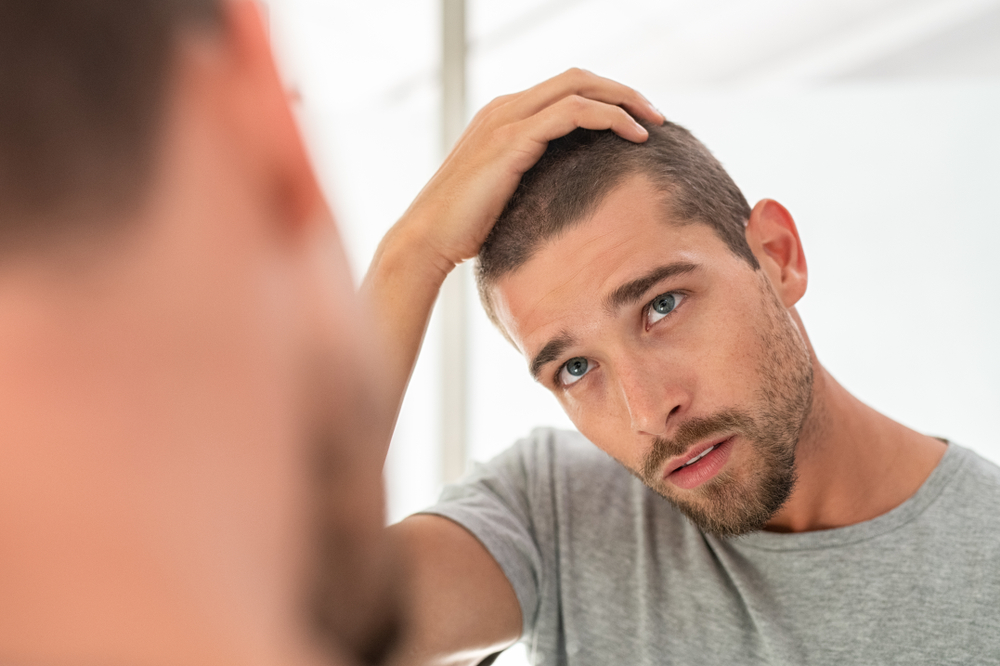
Hair or scalp trauma
Medical conditions aside, hair follicles and strands must be treated with care, in order to maintain healthy hair growth. Damage to your hair or scalp and severe skin conditions can cause more hair to fall out, while also impeding your ability to regrow hair.
Physical trauma to your hair or scalp can occur through a variety of ways, many seeming minor at the time, such as repetitive styling techniques that put stress on the hair.
Psychological reasons
If you’re aged between 26 and 41, studies show that you’re more than likely living in the most stressful years of your life. While we’ve highlighted the main stress factors as financial, job security and relationships, let’s take a look at how the level of stress you’re experience stacks up alongside older generations.
Approximately 40% of millennials suffer from stress induced by concerns with job security, a number that’s 10% higher than that recorded with the stress felt by Baby Boomers and Generation X.
What’s more, over 50% of adults aged between 26 and 41 years of age lose sleep over concerns with relationships, compared to just 1/3 of older generations feeling the same pressure.
With psychological factors and mental health issues playing a primary role in the cause of hair loss in men under the age of 40, it’s never been more important to develop identify strategies to overcome anxiety and stress in your daily life.
Insomnia
Further research from the American Psychological Association shows that 17% of all millennials report insomnia or sleep deprivation, caused by the stress of outstanding student loans and educational costs. While 17% may not seem like a shockingly high number, this figure equates to around three times more than their elders.
In men, compromised sleep habits have been known to negatively impact the production of androgens, responsible for the hormone called cortisol, which affect the production and nourishment of hair follicles.
Although stress is often a contributing factor for insomnia, other elements of modern society play into the rising numbers, with television and mobile devices in the bedroom, stress-riddled jobs and a string of late nights all increasing the chances of insomnia and hair loss.
Medications
Many of the serious medical conditions listed above require intensive treatment options for effective manageability.
While in many cases these types of medical conditions alone can result in hair loss at a young age, the medications prescribed for the treatment of serious illnesses may cause an increased rate of hair thinning or even full body hair loss.
Chemotherapy drugs are most well known for causing advanced stages of hair loss or, in some cases, will cause the patient to become completely bald, with hair fall out affecting under arm areas, eyelashes and eyebrows.
Alopecia areata
If you’ve noticed patchy bald spots across small areas of the entire scalp, you may be suffering from a type of hair loss known as alopecia areata. This condition is prevalent in people between the ages of 15 and 29 years, affecting both younger women and men.
Hair loss caused by this form of alopecia is often associated with a number of underlying health conditions, such as diabetes, thyroid disease and down syndrome.
Telogen effluvium
Trauma or stress related hair loss, caused by telogen effluvium, occurs as a type of temporary hair loss, when a person is experiencing extreme circumstances in their life.
Unlike hereditary hair loss, such as male pattern baldness, which follows a distinct thinning pattern or receding hairline across the scalp, telogen effluvium commonly appears as patchy hair loss, when the hair follicle is forced into a premature resting phase, causing advanced shedding to occur.
Hereditary hair loss
Permanent hair loss from a predisposed genetic condition is one of the most familiar forms of hair loss amongst men of all ages. If you’re in your 20s and begin to notice a receding hairline or growing bald patches, most of these cases can be attributed to male pattern baldness.
Male pattern baldness
Androgenetic alopecia, commonly referred to as male pattern baldness, accounts for more than 50% of all hair loss in men. As we age, hair growth slows, making the appearance of conditions such as male pattern baldness more easily visible.
As we now know, hair loss caused by male pattern baldness is becoming more widespread amongst men in their 20s, as hair follicle production and growth becomes more affected by increased stress levels.
Although it is the most common form of hair loss in men, unfortunately there is no cure for male pattern baldness. While this may be disheartening to hear, there are a number of highly effective hair loss treatment options available, which work to nourish the hair follicle and slow the rate of hair loss, to reduce the visible symptoms of male pattern baldness.
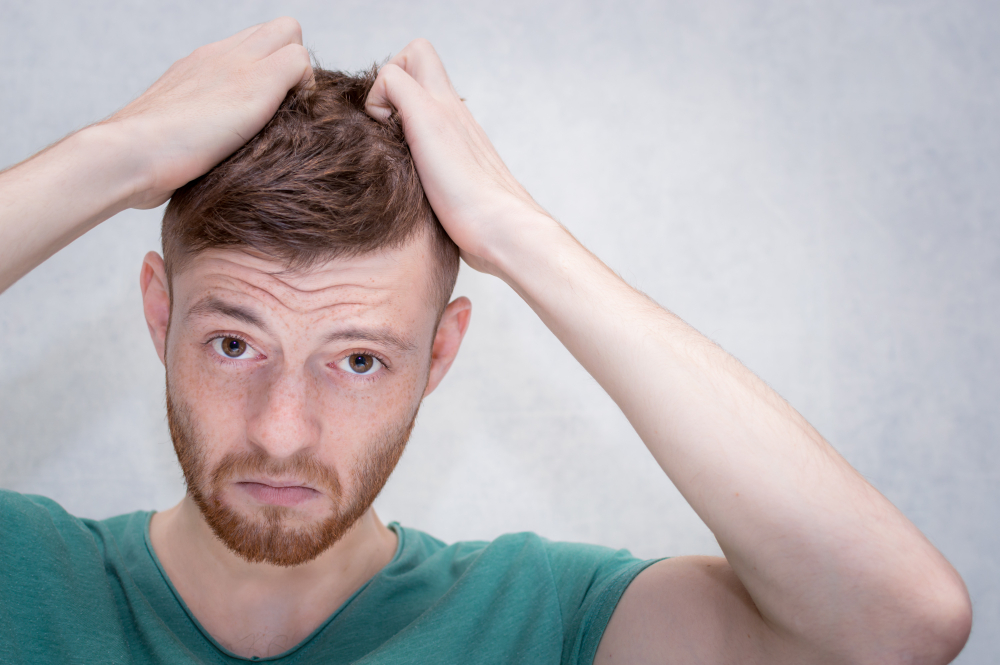
What does male pattern baldness look like?
Distinct hair thinning on the crown of the skull and a receding hairline are the most visible features of male pattern baldness. While the beginnings of bald spot might be what others first notice, most men will initially spot the telltale signs of a receding hairline seen in the reflection of a mirror.
What causes male pattern baldness?
Androgenetic alopecia is caused by a combination of genetic and hereditary factors. When considering genetic involvement, a male steroid hormone, known as dihydrotestosterone (DHT), binds the receptors in the scalp of genetically susceptible men, resulting in hair loss.
Even though male pattern baldness is a hereditary condition, it’s important to note that outside influences, such as sleep deprivation and stress, are likely to increase the chance of early onset, in predisposed men.
While male pattern baldness may not allow you to regrow lost hair, there are a number of available treatments that work to limit losing hair in the future and boost your existing hair’s health.
Hair loss treatments to improve hair growth.
Preventative treatments
A healthy diet is one of the simplest steps you can take to reduce and prevent hair loss at any age. Most young people living in today’s fast-paced, modern society don’t feel as though they have the time to prepare and stick to a balanced diet, however understanding how to counteract nutritional deficiencies with a healthy diet has the potential to reduce the rate of hair loss in your 20s.
According to a 2017 study, several nutritional deficiencies were highlighted in people with thinning hair, such as amino acids, which serve as the building blocks of protein. To combat the early signs of hair loss, try to avoid junk food and incorporate more protein rich foods into your diet, such as fish, unsalted nuts, eggs and yoghurt.
When all is said and done, however, sometimes eating a healthy diet just isn’t achievable every day. If this is your experience, the inclusion of a multivitamin can provide an efficient way to ensure your body is receiving the essential nutrients it needs to support hair growth.
Additionally, nourishing hair follicles and taking the time to care for your hair is another helpful preventative treatment, which is easy to implement into your daily routine. Switching to a detangling hair brush will help to reduce unnecessary, extensive hair loss. Washing with a mild shampoo will also help to keep the scalp clean and healthy, while using a harsher formula may lead to breakage, resulting in the appearance of thinning hair.
Healthy lifestyle
While poor nutrition can lead to early hair loss, other factors in your lifestyle may also cause you to lose hair at a younger age, such as exposure to pollution, smoking, vaping and prolonged time in the sun.
Regular exercise is needed for a healthy lifestyle and also works to increase blood flow through areas of the scalp, which can optimise hair growth. When engaging in outdoor exercise, be sure to practice simple acts, such as wearing hats and applying a moisturising treatment, to minimise any sun damage to your hair.
Natural remedies
While prescription medicine has been clinically proven as the best treatment for both male pattern baldness and female pattern baldness, there are also a number of natural remedies you can incorporate into your treatment plan, to encourage healthy hair growth.
While the research surrounding these natural hair loss treatments is limited, some people have reported promising results when using pure coconut oil, as a moisturising treatment to assist in the reduction of hair loss. Aloe vera is also used as another alternative treatment, commonly to rehydrate the skin and scalp after intensive sun exposure, for healthier hair follicles.
Medical treatments
As one of the most common health conditions affecting men, needless to say there has been a vast amount of research into the development of hair loss treatment options, over the years.
Whatever your preferences may be, the methods to treat hair loss range from non-invasive options, right through to cosmetic procedures and surgical solutions, such as hair transplants.
When you begin noticing hair loss, it is commonly recommended that you opt for a non-surgical solution, before jumping the gun to what could be an otherwise highly invasive and costly procedure.
Topical sprays and oral medications have proven to be highly effective in the management of androgenic alopecia (male pattern baldness), with a study showing 83% of men will retain their hair and not experience further hair loss. Commonly, a combination of both a prescribed medication and non-prescription treatment is used, in order to achieve the most effective results.
Let’s get your health sorted!
If you’ve been worried that your alone and other young people don’t experience hair loss, you can now lower your stress levels, knowing that certainly isn’t the case.
Whether you’re experiencing male pattern baldness or temporary hair loss, in most cases, you’ll discover that your condition is manageable. Start a convo with a men’s health specialist to find the right treatment for you.
Sources
American Academy of Dermatology Association. (2022) Hair loss types: Alopecia areata causes. (https://www.aad.org/public/diseases/hair-loss/types/alopecia/causes)
American Psychological Association. (2017) Stress in America: The State of our Nation. (https://www.apa.org/news/press/releases/stress/2017/state-nation.pdf)
Healthline. (2019) Can a scalp massage help your hair grow? (https://www.healthline.com/health/scalp-massage-for-hair-growth)
Healthline. (2019) Hair Loss Prevention: 22 Tips to Help Save Your Hair. (https://www.healthline.com/health/hair-loss-prevention)
NIH National Cancer Institute. (2020) Hair Loss (Alopecia) and Cancer Treatment. (https://www.cancer.gov/about-cancer/treatment/side-effects/hair-loss)
NIH National Library of Medicine. (1998) Prevalence of male pattern hair loss in 18-49 year old men. (https://pubmed.ncbi.nlm.nih.gov/9865198/)
Mayo Clinic. (2022) Chemotherapy and hair loss: What to expect during treatment. (https://www.mayoclinic.org/tests-procedures/chemotherapy/in-depth/hair-loss/)
